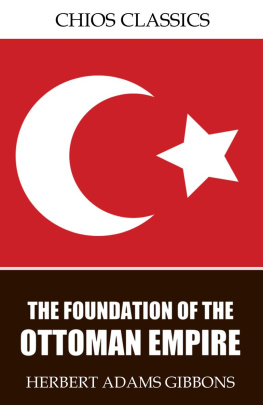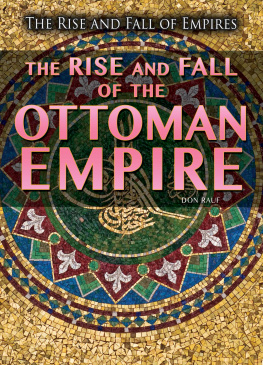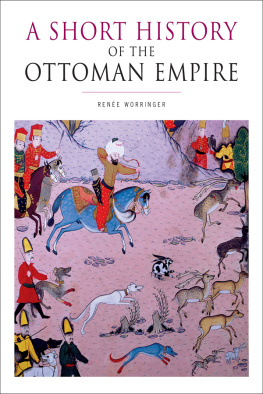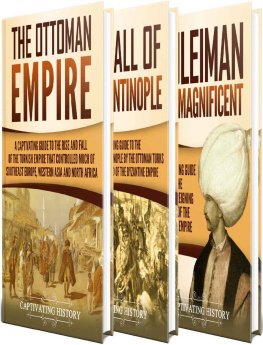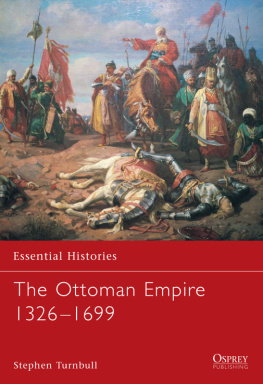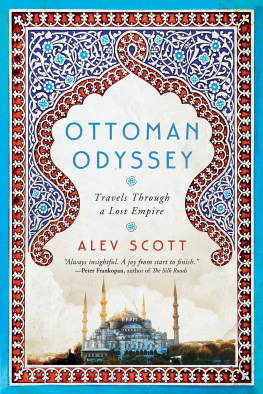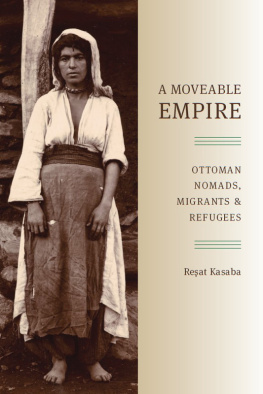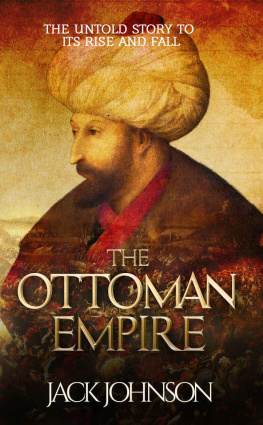Herbert Adams Gibbons - The Foundation of the Ottoman Empire
Here you can read online Herbert Adams Gibbons - The Foundation of the Ottoman Empire full text of the book (entire story) in english for free. Download pdf and epub, get meaning, cover and reviews about this ebook. publisher: MIT, genre: Detective and thriller. Description of the work, (preface) as well as reviews are available. Best literature library LitArk.com created for fans of good reading and offers a wide selection of genres:
Romance novel
Science fiction
Adventure
Detective
Science
History
Home and family
Prose
Art
Politics
Computer
Non-fiction
Religion
Business
Children
Humor
Choose a favorite category and find really read worthwhile books. Enjoy immersion in the world of imagination, feel the emotions of the characters or learn something new for yourself, make an fascinating discovery.
- Book:The Foundation of the Ottoman Empire
- Author:
- Publisher:MIT
- Genre:
- Rating:4 / 5
- Favourites:Add to favourites
- Your mark:
- 80
- 1
- 2
- 3
- 4
- 5
The Foundation of the Ottoman Empire: summary, description and annotation
We offer to read an annotation, description, summary or preface (depends on what the author of the book "The Foundation of the Ottoman Empire" wrote himself). If you haven't found the necessary information about the book — write in the comments, we will try to find it.
The Foundation of the Ottoman Empire — read online for free the complete book (whole text) full work
Below is the text of the book, divided by pages. System saving the place of the last page read, allows you to conveniently read the book "The Foundation of the Ottoman Empire" online for free, without having to search again every time where you left off. Put a bookmark, and you can go to the page where you finished reading at any time.
Font size:
Interval:
Bookmark:
THE FOUNDATION OF THE OTTOMAN Empire; A History of the Osmanlis up to the Death of Bayezid I
Herbert Adams Gibbons
PREFACE
Four years of residence in the Ottoman Empire, chiefly in Constantinople, during the most disastrous period of its decline, have led me to investigate its origin. This book is written because I feel that the result of my research brings a new point of view to the student of the twentieth-century problems of the Near East, as well as to those who are interested in fourteenth-century Europe. If we study the past, it is to understand the present and to prepare for the future.
I plead guilty to many footnotes. Much of my text is controversial in character, and the subject-matter is so little known that the general reader would hardly be able to form judgements without a constantbut I trust not wearisomereference to authorities.
The risk that I run of incurring criticism from Oriental philologists on the ground of nomenclature is very great. I ask their indulgence. Will they not take into consideration the fact that there is no accepted standard among English-speaking scholars for the transliteration of Turkish and Slavic names ? Wherever possible, I have adopted the spelling in general usage in the Near East, and in English standard lexicons and encyclopaedias. When a general usage cannot be determined, I have frequently been at a loss.
There was the effort to be as consistent in spelling as sources and authorities would permit. But where consistency was lacking in originals, a consistent transliteration sometimes presented difficulties with which I was incompetent to cope. Even a philologist, with a system, would be puzzled when he found his sources conflicting with each other in spelling, andas is often the casewith themselves. And if a philologist thinks that he can establish his system by transliterating the spoken word, let him travel from Constantinople to Cairo overland, and he will have a bewildering collection of variants before he reaches his journeys end. I was not long in Turkey before I learned that Osman and Othman were both correct. It depended merely upon whether you were in Constantinople or Konia ! After you had decided to accept the pronunciation of the capital, you were told that Konia is the Tours of Turkey.
My acknowledgements to kind friends are many. I am grateful for the year-in and year-out patience and willingness of the officials of the Bibliothque Nationale during long periods of constant demand upon their time and attention. Professors John De Witt, D.D., LL.D., of Princeton Theological Seminary, Duncan B. Macdonald, Ph.D., of Hartford Theological Seminary, and Edward P. Cheyney, Ph.D., LL.D., of the University of Pennsylvania, have read portions of the manuscript, and have made important and helpful suggestions. The whole manuscript has been read by Professors Talcott Williams, LL.D., of Columbia University, and R. M. McElroy, Ph.D., of Princeton University, who have not hesitated to give many hours to discussion and criticism of the theory that the book presents.
Above all, I am indebted for practical aid and encouragement in research and in writing, from the inception of the idea of the book until the manuscript went to press, to my wife, with her Bryn Mawr insistence upon accuracy of detail and care for form of narrative, and to Alexander Souter, D.Litt., Regius Professor of Humanity in Aberdeen University, my two comrades in research through a succession of happy years in the rue de Richelieu, rue Servandoni, and rue du Montparnasse of the queen city of the world.
H. A. G.
Paris, September 1, 1915.
CHAPTER I. OSMAN, A NEW RACE APPEARS IN HISTORY I
The traveller who desires to penetrate Asia Minor by railway may start either from Smyrna or from Constantinople. The Constantinople terminus of the Anatolian Railway is at Hadar Pasha, on the Asiatic shore, where the Bosphorus opens into the Sea of Marmora. Three hours along the Gulf of Ismidt, past the Princes Islands, brings one to Ismidt, the ancient Nicomedia, eastern capital of the Roman Empire under Diocletian. It is at the very end of the gulf. From Ismidt, the railway crosses a fertile plain, coasts the western shore of Lake Sabandja, and enters the valley of the Sangarius as far as Lefk. Here it turns southward, and mounts rapidly the course of the Kara Su, a tributary of the Sangarius, through the picturesque town of Biledjik, to a plateau, at the north-western end of which is Eski Sher, seven hours distant from Ismidt. Eski Sher is the ancient Dorylaeum. It was here that Godfrey de Bouillon in 1097 won from the Turks the victory that opened for his Crusaders the way through Asia Minor.
From Eski Sher there are two railway lines. One, running eastward, has its terminus at Angora, the ancient Ancyra, after thirteen hours of rather slow running. The other, the main line, runs south to Afion Kara Hissar, where the line from Smyrna joins it, and then south-west to Konia, the ancient Iconium, which is the western terminus of the new Bagdad Railway. The time from Eski Sher to Konia is fifteen hours.
From Lefk or from Mekedj, near the junction of the Kara Su and the Sangarius, one can drive in four hours west to Isnik (ancient Nicaea), or in twelve hours to Brusa, which lies at the foot of Keshish Dagh (Mount Olympus). Between Lefk and Eski Sher, where the railway begins to mount above the river-bed of the Kara Su, is Biledjik. Between Eski Sher and Biledjik is Sugut. West from Eski Sher, six hours on horse across one low mountain range, lies Inocnu. South from Eski Sher, a day by carriage, is Kutayia. There is a short branch line of the Anatolian Railway to Kutayia from Alayund, two and a half hours beyond Eski Sher on the way to Konia.
If one will read the above paragraphs with a map before him, he will readily see that this country, the extreme north-western corner of Asia Minor, corresponds roughly to the borderland between the Roman provinces of Phrygia Epictetus and Bithynia, and is near to Constantinople. Eski Sher, Sugut, and Biledjik are close to Brusa, Nicaea, and Nicomedia. Owing to the convenient waterways furnished by the Gulfs of Mudania and Ismidt, Brusa, Nicaea, and Nicomedia have always been within a days sail of Constantinople, even in the periods of primitive navigation. From the hills behind Eski Sher, Mount Olympus is the commanding landmark of the western horizon. From Constantinople, Mount Olympus is easily distinguishable even in dull weather.
It was this country, adjacent to Constantinople, and separated from the rest of Asia Minor by rugged mountain ranges and the dreary, treeless plateau stretching eastward towards the Salt Desert, which gave birth to the people who, a century after their appearance, were to inherit the Byzantine Empire and to place their sovereigns upon the throne of the Caesars.
II
At the end of the thirteenth century, Asia Minor, so long the battleground between the Khalifs and the Byzantines, almost entirely abandoned by the latter for a brief time to the Seljuk emperors of Rum, who had their seat at Konia, then again disturbed by the invasion of the Crusaders from the west and the Mongols from the east, was left to itself. The Byzantines, despite (or perhaps because of !) their re-establishment at Constantinople, were too weak to make any serious attempt to recover what they had lost to the Seljuk Turks. The Mongols of the horde of Djenghiz Khan had destroyed the independence of the Sultanate of Konia, and had established their authority in that city. But they made no real effort to bring under their dominion the districts north-west and west of Konia to which they had logically fallen heir.
At the beginning of the fourteenth century, we find two Christian kingdoms, Trebizond and Little Armenia, or Cilicia, at the north-eastern and south-eastern extremities of the peninsula. In the north-western corner, the Byzantines retained Philadelphia, Brusa, Nicaea, Nicomedia, and the districts in which these cities were locateda narrow strip along the Hellespont, the Sea of Marmora, and the Bosphorus. Asia Minor, without even a semblance of centralized authority, was to him who could gain and who could hold.
Font size:
Interval:
Bookmark:
Similar books «The Foundation of the Ottoman Empire»
Look at similar books to The Foundation of the Ottoman Empire. We have selected literature similar in name and meaning in the hope of providing readers with more options to find new, interesting, not yet read works.
Discussion, reviews of the book The Foundation of the Ottoman Empire and just readers' own opinions. Leave your comments, write what you think about the work, its meaning or the main characters. Specify what exactly you liked and what you didn't like, and why you think so.

